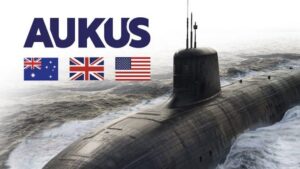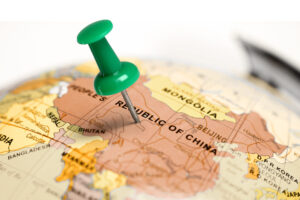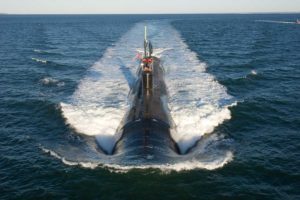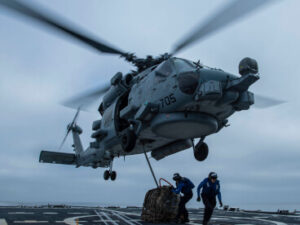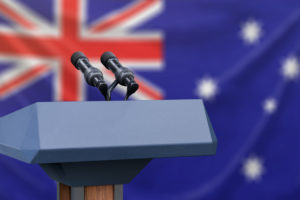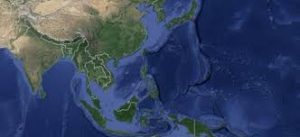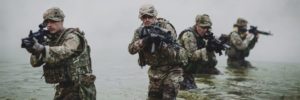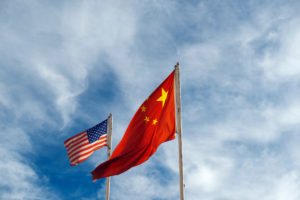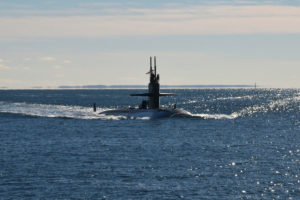The Center for a New American Security (CNAS) and the National Broadcasting Company’s (NBC) Meet the Press conducted a war game in June based on a Chinese invasion of Taiwan. Chuck Todd presided for NBC, while former U.S. Department of Defense (DoD) Undersecretary for Policy Michelle Flournoy and CNAS CEO Richard Fontaine respectively joined the American (Blue) and Chinese (Red) teams. The American side also included Reps. Mike Gallagher (R-Tenn.) and Mikie Sherrill (D-NJ), two well-informed members of the House Armed Services Committee. The NBC/CNAS report could not have been timelier, given the noisy Chinese military exercises in the area following House Speaker Nancy Pelosi’s early August visit.
NBC and CNAS are also to be congratulated for kicking off what will likely be a lengthy process of educating the American people on what more needs to be done to deter the Chinese from conducting a serious provocation, like a blockade or an outright invasion of Taiwan. The war game dramatized the difficulties the United States will face in a Taiwan Strait contingency. In the end, China detonated a nuclear device over the eastern Pacific; both sides escalated to conventional attacks on each other’s territory; and American forces failed to achieve air superiority over Taiwan. They also failed to prevent the Chinese from establishing a lodgment on the northern end of the island.
For all its success in encouraging greater public discourse around a potential conflict with China, the game itself had its faults. Only Chinese and American teams played, while a more realistic scenario would have included, at a minimum, teams from our allies Japan, Australia, and the Philippines. The broadcast included only snippets of each team’s deliberations, which must have been difficult and complicated. The report did not reveal the initial conditions leading to a Chinese invasion or the military balance in the region at the outset of hostilities, in which the United States is at a growing disadvantage. Nor did it tally the staggering losses in materiel and lives, both military and civilian, suffered by all sides.
The closing session of the report, in which participants enumerated lessons learned, was particularly illuminating. The American team made it clear that our current regional military posture cannot deter the Chinese much longer. The team acknowledged the immense challenge to adequate military force generation posed by our lengthy trans-Pacific lines of communication. Players recognized that the Chinese can deploy formidable naval, air-, and land-based missile forces capable of denying American aircraft carriers access to the seas within the “first island chain,” that area of the Western Pacific bordered by the Chinese coast in the west and the island nations of the Pacific littoral in the east. Finally, American players underscored the necessity of relying on our allies, and not just for bases on their territory—they will need to join the fight. “We need to build an Asian NATO,” Todd exclaimed.
The alliance managers in London, Canberra, and Washington who devised the AUKUS agreement deserve a pat on the back for acting in concert with calls for increased allied cooperation. The September 2021 agreement established a broad trilateral technology exchange program, including the transfer of nuclear-powered submarine know-how from the British and American Navies to the Australian Navy. The deployment of new attack submarines will be a long-term project. Experts don’t expect the subs to hit the water until the 2030s or ’40s, and the gap in capabilities poses a problem for the allies. But the prospect of advanced, high-endurance Australian attack submarines operating in the approaches to the Malacca, Lombok, and Sunda Straits will greatly complicate Chinese war planning and, hopefully, give pause to future PLA Navy officers with itchy trigger fingers. Meanwhile, AUKUS will better weld together three of the world’s most technologically advanced militaries in a partnership bound, in the shorter term, to strengthen our forces’ overall interoperability.
The attack sub’s 10- to 20-year deployment horizon notwithstanding, the surprise announcement of AUKUS was of immediate diplomatic value to the allies. It put the Chinese on their back feet—the asperity of their response demonstrated that. The agreement sent a high-decibel signal to China and the region that the United States will remain engaged in the Western Pacific and Indian Oceans. It also signaled that, after much domestic debate in the late teens, Australia has committed itself to joining a possible fight. The region now knows that growing Chinese military capabilities and the increased assertiveness that has come with them have imposed a diplomatic price—the strengthening of a diplomatic and military coalition.
The back-patting stops there. For while the AUKUS agreement reflects the deftness with which the three allies approached regional diplomacy, it also reflects the yawning deficiencies in American regional strategy, posture, and, most of all, leadership. First, the United States is falling behind militarily. For example, last year’s DoD China Military Power Report revealed that the U.S. Navy had 293 ships compared to the PLAN’s 350. The U.S. Navy, however, has global responsibilities, and the USINDOPACOM website states that there are only 50–70 American warships and submarines present in the Western Pacific at any one time. As early as 2015, a RAND comparison across 10 different military capabilities found that U.S. forces face a “receding frontier…of dominance” in multiple areas, particularly in a confrontation over Taiwan.
Second, we are lagging diplomatically. Successive presidents have paid insufficient attention to the region, and President Biden appears to be guilty of the same inattention to Southeast Asia displayed by many of his predecessors. He failed to include any Southeast Asian leaders in his initial round of post-inauguration phone calls, and he has yet to visit the region. A successful U.S.-ASEAN Summit in May compensated to some extent, but American ambassadors to our allies the Philippines and Thailand were not confirmed by the Senate until May and August respectively, more than a year after Biden’s inauguration. The president’s attention has been justifiably riveted on Ukraine since early this year, but Southeast Asia still takes notice of imbalances in American engagement. Hopefully, the president will remedy this with an autumn trip to the region for the East Asia and APEC summits.
Third, the United States continues to stumble economically. Economic growth and expanded trade are the highest items on Southeast Asia’s agenda. When President Trump threw out the Trans-Pacific Partnership (TPP) agreement, he sacrificed strategic as well as economic advantages. My experience as Ambassador to Hanoi underscored this. In addition to offering economic benefits to participants like Vietnam, the TPP also offered them the opportunity to diversify their trading partners and further solidify American regional presence. The Vietnamese understood this instinctively, as did President Obama, despite his dilatory approach to Congressional approval. In May, the Biden administration offered up a damp squib—the Indo-Pacific Economic Framework (IPEF)—as an alternative to the Comprehensive and Progressive Agreement for Trans-Pacific Partnership (CPTPP), which garnered a decidedly mixed regional response. While the framework provides opportunities in such areas as digital trade, it offers no market opening, giving regional players little incentive to make concessions to the United States in areas like labor practices and the environment.
Fourth, structural challenges in the region will likely prevent us from establishing an “Asian NATO” (sorry, Chuck!). Since the end of the Cold War, U.S. presence in Northeast Asia has remained remarkably stable. We can boast strong, capable allies in Northeast Asia. We deploy significant forces in Japan and the Republic of Korea (South Korea, or ROK), and both allies field formidable forces of their own that are eyeing new roles that will be advantageous to the United States.
It’s just the opposite in Southeast Asia, where we station few forward deployed forces and our alliances with the Philippines and Thailand are adrift. Secretary of State Blinken had what looked like an encouraging exchange with President Marcos on the importance of the alliance, but doubts about Manila’s reliability remain. This is especially concerning since Philippine cooperation during a Taiwan or a South China Sea contingency will be particularly important. Nor can other Southeast Asian countries offer immediate alternatives to reliance on the Philippines in the event of a Taiwan contingency. Singapore’s Prime Minister Lee Hsien Loong made this clear in a much-cited 2020 Foreign Affairs article. Southeast Asian countries do not want to be forced to choose between Washington and Beijing, Lee declared. “They cannot afford to alienate China, and other Asian countries will try their best not to let any single dispute dominate their overall relationships with Beijing,” he wrote.
The Southeast Asian propensity to hedge between the powers presents a stark challenge to American diplomats and military planners who wish to diversify our military access arrangements to strengthen deterrence. Even front-line-state Vietnam is reluctant to move too quickly to support the American military for fear of a Chinese backlash.
Rebuilding a credible deterrent in Southeast Asia will require more than the revival of John Foster Dulles’s Southeast Asia Treaty Organization (SEATO), an ill-fated 1950s attempt to rally the region to a multilateral alliance. It will require the kinds of networking we have been working at since the Obama administration, not only to include AUKUS and the Quad, but the proactive security networking of our allies as well, particularly Japan and Australia. It will take the development of new operational concepts that do not rely solely on the ability to initiate combat missions from allied territory. It will also take determination to shift Pentagon resources in ways that support new operational concepts and the tools necessary to implement them.
Finally, and most importantly, we appear to be lacking in presidential leadership. President Trump’s deficiencies in this regard were well known. He threw American domestic politics down the rabbit hole, pulled us out of TPP, abused our allies, ignored three out of four East Asian Summits, and postured his way through a series of carnivalesque encounters with Kim Jung Un. We can credit Trump’s administration with the release of a National Security Strategy that put great power competition front and center, but in the absence of meaningful decisions on national priorities and resource allocations, it was all talk.
Presidential inattention may extend to the task of gearing up the U.S. government to compete credibly with China. The Biden administration has yet to articulate a China strategy. The presidential leadership required for establishing priorities, making the hard resource choices, and adopting new operational concepts also appears to be lacking. The Department of Defense and the military services, for example, require a strategic vision and a timetable imposed by the president in order for the Pentagon’s many agencies to agree on how to proceed. While DoD civilians and our Indo-Pacific Commander agree that we need more resources, they have appeared, until recently, unable to agree on how much money we need or what that money should buy. In the same vein, Marine Corps Commandant Gen. David Berger, the only military service chief who has tackled the China challenge creatively, appears to be under sustained fire from members of Congress, other services, and even retired Marine officers with an interest in maintaining the status quo.
AUKUS and its partner institution, the Quad, will contribute greatly to a more vigorous diplomacy and enhanced deterrence in the Indo-Pacific. But much work needs to be done at the senior-most levels of the U.S. government to rectify faltering economic and diplomatic strategies in the region and put the sinews of a new national approach in place. Our allies can help. News reports indicate that AUKUS originated with the Australians, who first took the idea to their British colleagues. Even while we continue the work of adapting our own strategic footing, the deal provides us with a good example of how our nimbler allies can prod us to take bold and meaningful action.
